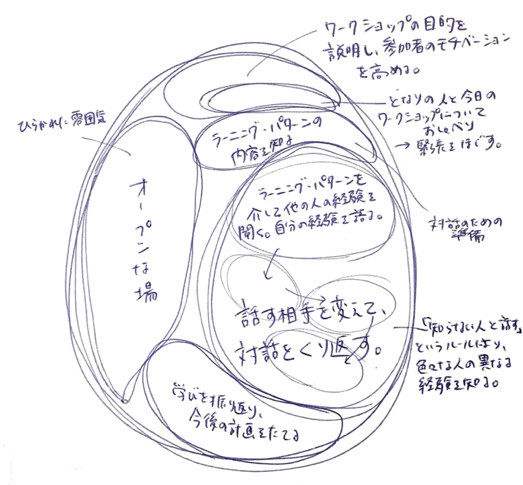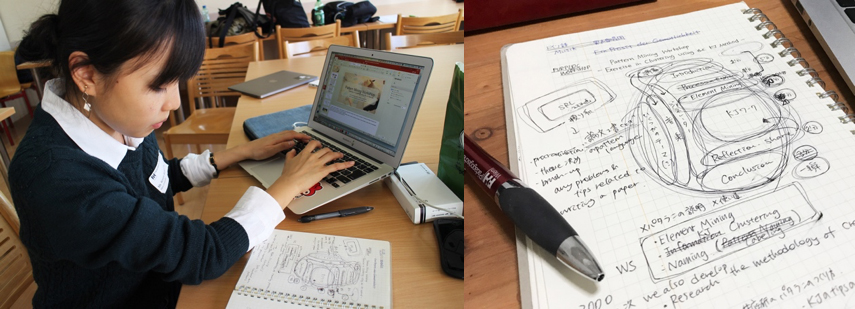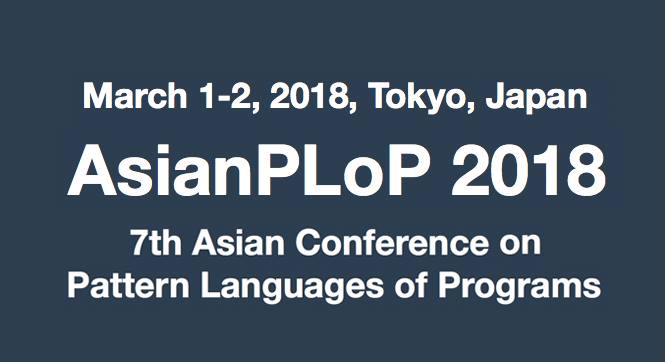【論文公開】「全体性のたまご」によるワークショップデザイン技法
2018年3月1・2日に早稲田大学で開催される国際学会AsianPLoP2018 (7th Asian Conference on Pattern Languages of Programs)で発表する(ライターズ・ワークショップにかける)論文の2つ目は、「『全体性のたまご』によるデザイン技法:全体から分化させるワークショップとプレゼンテーションのつくりかた」です。僕や井庭研が日々実践し、授業「ワークショップデザイン」で教えている、ワークショップ(そして、創造的なプレゼンテーション)のつくりかたです。
「『全体性のたまご』によるデザイン技法:全体から分化させるワークショップとプレゼンテーションのつくりかた」
(井庭 崇, 宗像 このみ)
Abstract:
本論文では、ワークショップやプレゼンテーションなど、参加者(聴き手)の創造的な学びを促す活動のデザイン(設計)において、「全体性」を重視したデザインを可能にするための方法論を提案する。このデザイン技法は、建築家であり、パターン・ランゲージの提唱者であるクリストファー・アレグザンダー(Christopher Alexander)の『時を超えた建設の道(1979)』や『The Nature or Order』の考え方にもとづき、全体から部分へと分化させ、「15の幾何学的特性」が生じるようにつくり込むことで、いきいきとした活動をデザインすることを支援するものである。本論文では、アレグザンダーの理論とこの手法との関係を明らかにした上で、対話ワークショップのデザインを具体的に例示し、さらに、教育現場における活用例について紹介する。
全体から分化させてデザインしていく

ラーニング・パターンを用いた対話ワークショップの「全体性のたまご」

井庭研メンバーは、実際に日々描いています。これは昨年オーストリアで行ったワークショップをつくっているところ。

井庭 崇, 宗像 このみ, 「『全体性のたまご』によるデザイン技法:全体から分化させるワークショップとプレゼンテーションのつくりかた」, 7th Asian Conference on Pattern Languages of Programs(AsianPLoP2018) , 2018
論文PDF: http://web.sfc.keio.ac.jp/~iba/papers/AsianPLoP18_WholenessEgg_WWS.pdf
この論文に興味を持っていただいた方は、ぜひ、3月1・2日に早稲田大学で開催される国際学会AsianPLoP 2018 (7th Asian Conference on Pattern Languages of Programs)にお越しください。そこでライターズ・ワークショップという場が設けられ、この論文について語り合う時間があります。ぜひ、事前登録の上、ご参加ください。

「『全体性のたまご』によるデザイン技法:全体から分化させるワークショップとプレゼンテーションのつくりかた」
(井庭 崇, 宗像 このみ)
Abstract:
本論文では、ワークショップやプレゼンテーションなど、参加者(聴き手)の創造的な学びを促す活動のデザイン(設計)において、「全体性」を重視したデザインを可能にするための方法論を提案する。このデザイン技法は、建築家であり、パターン・ランゲージの提唱者であるクリストファー・アレグザンダー(Christopher Alexander)の『時を超えた建設の道(1979)』や『The Nature or Order』の考え方にもとづき、全体から部分へと分化させ、「15の幾何学的特性」が生じるようにつくり込むことで、いきいきとした活動をデザインすることを支援するものである。本論文では、アレグザンダーの理論とこの手法との関係を明らかにした上で、対話ワークショップのデザインを具体的に例示し、さらに、教育現場における活用例について紹介する。
全体から分化させてデザインしていく

ラーニング・パターンを用いた対話ワークショップの「全体性のたまご」

井庭研メンバーは、実際に日々描いています。これは昨年オーストリアで行ったワークショップをつくっているところ。

井庭 崇, 宗像 このみ, 「『全体性のたまご』によるデザイン技法:全体から分化させるワークショップとプレゼンテーションのつくりかた」, 7th Asian Conference on Pattern Languages of Programs(AsianPLoP2018) , 2018
論文PDF: http://web.sfc.keio.ac.jp/~iba/papers/AsianPLoP18_WholenessEgg_WWS.pdf
この論文に興味を持っていただいた方は、ぜひ、3月1・2日に早稲田大学で開催される国際学会AsianPLoP 2018 (7th Asian Conference on Pattern Languages of Programs)にお越しください。そこでライターズ・ワークショップという場が設けられ、この論文について語り合う時間があります。ぜひ、事前登録の上、ご参加ください。

The Nature of Order | - | -